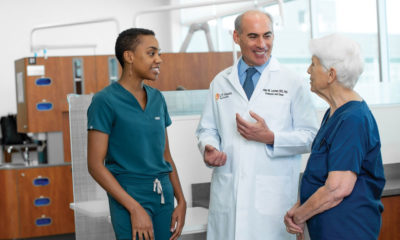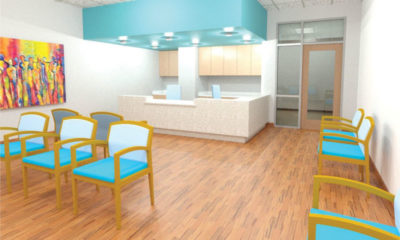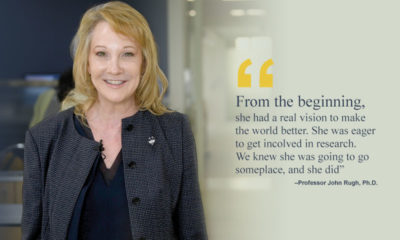Curriculum Revamped
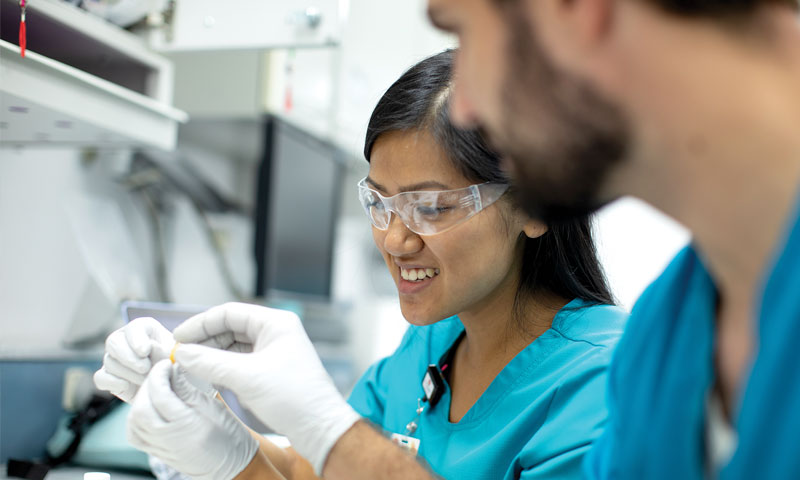
Integrated Learning Prepares Students for New Exam
By Catherine Duncan
In 2013, the School of Dentistry created a task force called the Biomedical and Preclinical Science group, known as BIOPSCI, to perform a critical self-assessment of the first- and second-year curriculum. The group was tasked with evaluating the curriculum in terms of the school’s mission of graduating the next generation of lifelong learners.
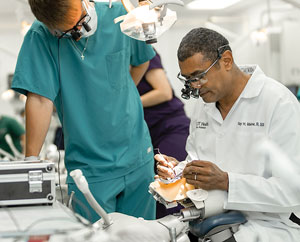
Adriana Segura, D.D.S., M.S., associate dean for academic, faculty and student affairs, said BIOPSCI’s assessment also helped prepare the school for the Integrated National Board Dental Examination which will be implemented in 2020 to replace the two-part National Board Dental Examination.
“Historically, students had to take Part I that covered science and Part II that covered clinical,” she said. “The entire country is moving to this integrated exam. This committee worked for four years and completely revamped the curriculum.”
Goals of revising the curriculum for the first two years included:
- Replacing numerous stand-alone silo-based courses with fewer integrated thematic-based courses;
- Increasing early exposure of novice student to hands-on clinical activities;
Improving the integration of dentistry as an integral component of overall patient health; - Aligning evidence-based curriculum content to better prepare graduates to manage an increasingly medically complex patient population;
- Improving the smooth and efficient transformation of the didactic students’ learning in a clinical environment;
- Developing and graduating critical thinkers;
- Meeting new predoctoral accreditation standards; and
- Preparing students to successfully challenge the pending new single Integrated National Review Board Examination.
The group recommended a total deconstruction and reconstruction of the DS1 and DS2 curriculum. BIOPSCI recommended replacing the existing 52 silo-based DS1 and DS2 courses with three thematic tracks:
- Human Health and Disease—(1) Students learn normal development, structure, function and pathology of the oral facial complex, including teeth, periodontium, oral mucosa, bone and contiguous structures. (2) Students learn the foundational principles of systemic health and disease with emphasis on disease pathophysiology, recognition of clinical manifestations, and systemic-oral health interrelationships.
- Introduction to Patient Care—Students will acquire skills in non-restorative areas of dental care and continue to establish the foundations of clinical dental practice to prepare them to enter the clinic.
- Foundations of Restoration Dentistry—Students begin to establish foundations and develop the skills of managing hard tissue dental disease.
“It was determined we needed to integrate the basic sciences and clinical courses and make sure the students develop hand skills earlier. We needed to make the transition easier to the DS3 clinical year,” Dr. Segura said.
As a BIOPSCI group member and faculty member, Michaell Huber, D.D.S. Class of 1980, clinical professor of comprehensive dentistry, said he is a strong proponent of the new curriculum.
“I’m convinced this is the way to go. We had an existing curriculum that I was a product of. We had 50-plus different courses that never really tied together. Now, we expect the students to be able to put all the knowledge together for clinical,” said Dr. Huber, who serves as co-track leader for the Human Health and Disease track.
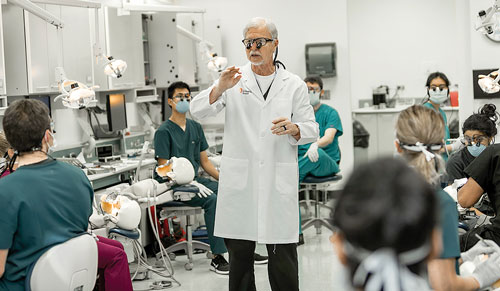
The new curriculum is designed so all didactic material presented is reinforced concurrently with clinical application. The clinical activity of DS1 and DS2 students is significantly increased and includes opportunities for students to support and deliver clinical procedures.
In addition, the curriculum features additional courses addressing behavioral science, nutrition, patient assessment, professionalism, practice management, evidence-based practice and other topics combined with basic science or pre-clinical laboratory courses.
The new curriculum was implemented in July 2017 with current third-year dental students.
Dr. Segura said, “We are already seeing the difference that this curriculum is making. Our DS4 students are amazed by what the DS2 students already know. They are better prepared when they start their clinical years.
Anthony L. Jaramillo, third-year dental student, is a member of the first class to begin school with the new curriculum.
“During the application process, we were told about the new curriculum. Dr. (Kay) Malone (director of admissions) explained it to me. It sounded very interesting but a little nerve wracking too. But, the School of Dentistry has a great reputation so I trusted it,” said Jaramillo, whose father, Carlos Jaramillo, D.D.S., graduated from the program in 1988.
The younger Jaramillo said overall he was pleased with his education over the last two years. “The way they integrated everything was very unique. During my undergraduate education, all the topics were siloed. Here, we learned everything together. It helped compartmentalize my thinking.
“Also, we started the Foundations of Restoration Dentistry early so we were able to start developing our hand skills earlier. It paid off. We did better than previous classes,” he said. “The school did a great job listening to us during the process. They wanted our feedback. Because of the new curriculum, we feel more comfortable going into our third year.”
Dr. Huber said the response from the first class has been positive. “Hopefully, they are seeing how what they are learning is applicable to caring for patients. I think this is creating more critical thinking which will benefit them throughout their careers.
“The proof will be in the pudding when the students start taking the new board exam,” he added.
The DS1 students who are beginning the program in the fall of 2019 will be the first class to take the new integrated board exam. The timing of the exam also has changed. Previously, dental students took Part I at the end of their second year and Part II during their senior year. Now, the integrated exam will be taken at the end of their third year.


